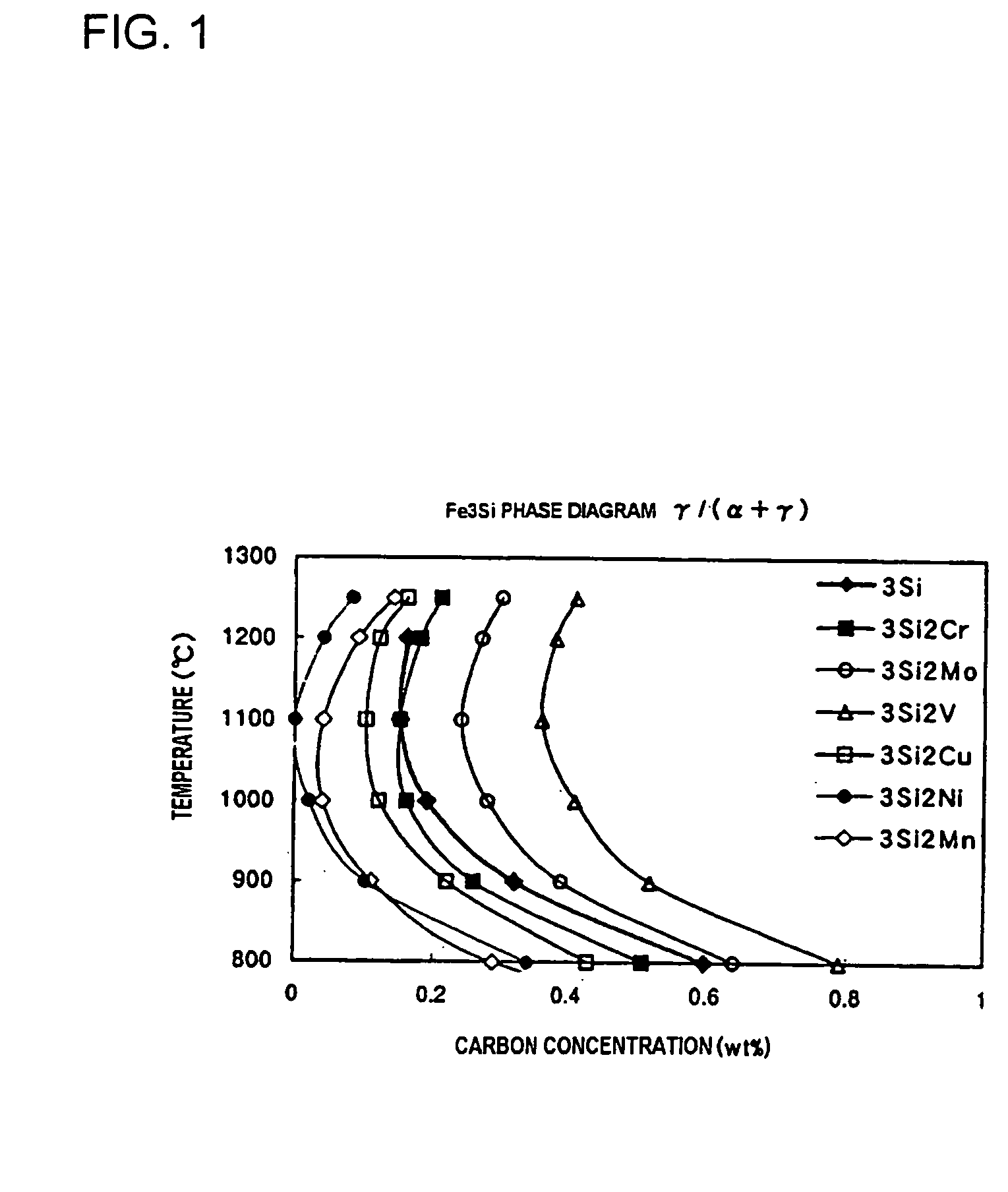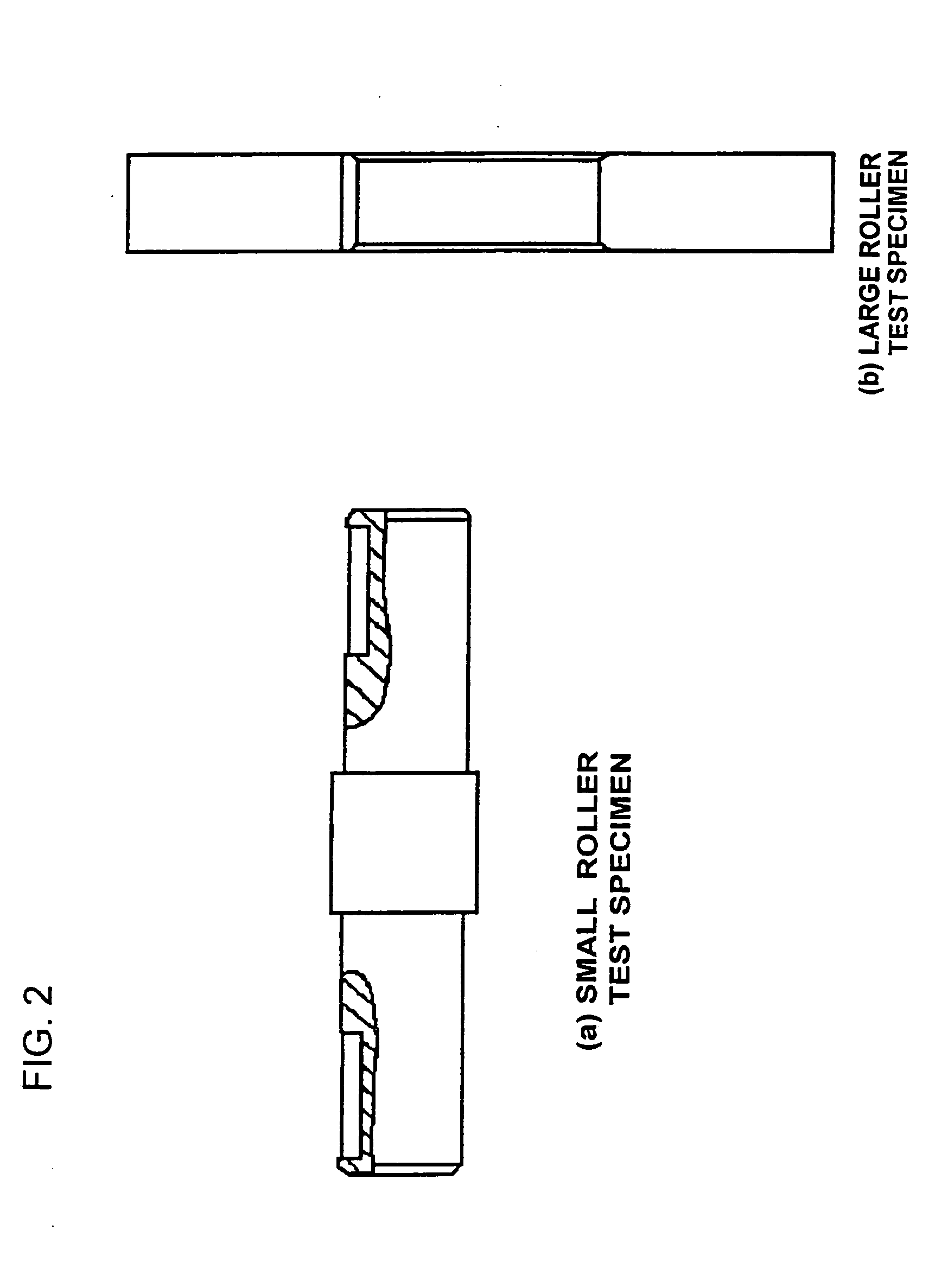Rolling elements
a technology of rolling elements and gears, applied in the field of rolling elements, can solve the problems of damage to carburized quenched gears, affecting the performance of the reducer used for running and turning such machines, and impulsive load on the gears of the reducer used for running and turning such machines, and achieves excellent charpy impact characteristics, and improved impact load resistance of the gear
- Summary
- Abstract
- Description
- Claims
- Application Information
AI Technical Summary
Benefits of technology
Problems solved by technology
Method used
Image
Examples
example 1
The Pitting Resistance of Quenched, Tempered Carbon Steel and Carburized, Quenched, Case-Hardened Steel
(Preliminary Test)
[0081] In this example, a roller pitting test was conducted with the test specimen shown in FIG. 2 and the pitting resistance of various quenched, tempered carbon steels and carburized, quenched, case-hardened steels was checked to investigate the rolling contact fatigue strength of the tooth flanks of gears. Table 1 shows the chemical compositions of the various carbon steels and case-hardened steels used in this example. These steel materials were respectively shaped into the small roller test specimen shown in FIG. 2(a) and the test specimens No. 1, 2 and 4 were subjected to water quenching after heating at 820° C. for 30 minutes, and then tempered at 160° C. for 3 hours, followed by testing. The specimen No. 3 was quench-hardened, at its rolling contact surface, using a 40 kHz high-frequency power source after thermal refining and then subjected to temperin...
example 2
Checking of Temper Softening Resistance
[0086] Table 2 shows the alloy compositions employed in this example. Thermal treatment was carried out in such a way that after heated at 810 to 870° C. for 30 minutes, each test specimen was subjected to water cooling and then tempering at 300° C. or 350° C. for 3 hours. Thereafter, the Rockwell hardness HRC of each test specimen was checked and the effect of the addition of each alloy element on the hardness was analyzed.
TABLE 2TPNo.CSiAlMnNiCrMoVBNo.60.451.450.461.490.520.140.0018No.70.491.450.461.011.030.150.0019No.80.470.310.462.011.030.150.0019No.90.490.290.451.51.490.230.0019No.100.361.770.60.620.110.0026No.110.450.950.680.011.290.50.0029No.120.390.931.020.080.970.950.5No.130.430.260.441.010.480.001No.140.470.250.41.011.050.0018No.150.461.50.410.510.002No.160.450.240.41.020.480.310.0011No.170.451.460.390.960.980.001No.180.410.250.3510.490.0017No.190.522.30.570.11No.200.980.270.481.47No.210.550.230.71No.220.770.210.74No.230.450.211.26...
example 3
An Improvement in Pitting Resistance by Use of Steel Materials Having Excellent Temper Softening Resistance 1
[0091] Table 3 shows the alloy components of the steel materials used in this example. The test specimens No. P1 to No. P10 were subjected to tempering at 160° C. for 3 hours subsequently to quenching at 850 to 920° C., whereas the test specimens No. 11 and No. 12 were subjected to induction hardening under the same high frequency heating condition as in Example 1. A roller pitting test was conducted on these test specimens.
TABLE 3300° C.CSiAlMnNiCrMoVBcalculated HRCNo.P10.340.211.471.170.170.1153.96No.P20.391.490.490.510.340.0553.91No.P30.411.510.720.320.1551.09No.P40.411.50.710.320.160.351.99No.P50.450.181.260.530.50.2155.94No.P60.551.510.710.150.1654.48No.P70.611.210.750.1454.34No.P80.620.211.240.530.1259.31No.P90.451.021.260.490.1258.78No.P100.610.251.470.930.981.040.3562.27No.P110.831.010.310.550.960.3862.11No.P121.210.20.520.521.010.510.466.62
[0092] The test for chec...
PUM
| Property | Measurement | Unit |
|---|---|---|
| contact fatigue strength | aaaaa | aaaaa |
| pressure | aaaaa | aaaaa |
| temperature | aaaaa | aaaaa |
Abstract
Description
Claims
Application Information
 Login to View More
Login to View More - R&D
- Intellectual Property
- Life Sciences
- Materials
- Tech Scout
- Unparalleled Data Quality
- Higher Quality Content
- 60% Fewer Hallucinations
Browse by: Latest US Patents, China's latest patents, Technical Efficacy Thesaurus, Application Domain, Technology Topic, Popular Technical Reports.
© 2025 PatSnap. All rights reserved.Legal|Privacy policy|Modern Slavery Act Transparency Statement|Sitemap|About US| Contact US: help@patsnap.com



